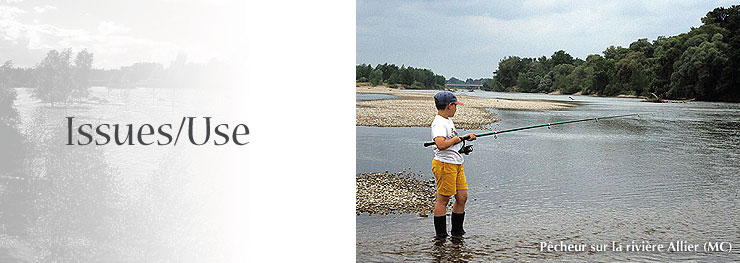|
The River Allier offers mankind a wealth of natural resources. It has always been fully integrated into the organization of the land, and the most important towns in the Allier catchment basin (Brioude, Issoire, Clermont-Ferrand, Vichy, Moulins) are on the banks of the river or close to it. But the recent development of a society oriented towards short-term needs has not taken account of the equilibrium of the river, and has not evaluated the consequences for future generations.
|
AUVERGNE'S SPINAL CORD
Since the dawn of time, the Allier, even more than other rivers, has been a vital line of communication and travel route in Auvergne. River trade by boat probably began well before the time of the Celts. Activity on the waterway declined with the arrival of the railways at the end of the 19th century. Today, the main SNCF regional railway line still follows the course of the River Allier, as do major trunk roads.

THE ALLIER, A SOURCE OF DRINKING WATER
The Allier’s alluvial groundwater is a huge reservoir holding water of generally good quality. It thus provides an excellent supply of drinking water, of which a great deal is extracted today. In fact, the Allier supplies drinking water for over 60% of the population of Puy-de-Dome and only a little less in the Bourbonnais. The total volume extracted for human consumption from the Allier’s alluvial bed is about 2.5 m3/s. The quality of the aquifer is such that water extracted in Brioude and Clermont-Ferrand, for example, can be used immediately; it is simply chlorinated to prevent deterioration in the mains. Further downstream, the situation is very different, as some abstractions regularly exceed permitted concentrations of nitrates.
In addition to human consumption, a lot of water is pumped for industrial and agricultural activities, some of them major consumers of water.

WETLANDS: NATURAL INFRASTRUCTURES
Through their role as filters, riverine wetlands play a vital part in preserving the water resource, and at no cost at all to the community. Various studies by scientists and research groups are beginning to put a figure on the economic benefit supplied by the functioning of the wetlands.
AGRICULTURAL DEVELOPMENT AT THE EXPENSE OF THE ALLIER
In the recent past, indeed until the nineteen-fifties, the banks of the Allier were mainly given over to pasture for cattle. Farmers would put livestock graze in accordance with the caprices of the river, moving them back as erosion advanced and taking them away during flooding. The riverside landscape was completed with a few fields used for cereals.
In the nineteen-sixties, agricultural mechanization and land consolidation brought intensified production in their train. Agricultural irrigation increased very considerably, so that today over 20,000 ha are irrigated, mainly for maize. These changes in farming practices have had major direct consequences with the passage of time: disappearance of habitats, deterioration in the quality of the water table and river, reduced flow in summer, etc. These practices have become incompatible with the vagaries of the Allier, and have also led to many development measures (river-bank rockfill to protect crops, construction of irrigation dams, etc.).
The extensive pastures have now become rare, and it is difficult to maintain them with current agricultural and environmental subsidies. It is necessary to restore balance to farming activities, the foundation for sustainable development.

ALLUVIA: AN OVEREXPLOITED NATURAL ASSET
The deposits of the alluvial plain are in themselves a very important natural and economic resource of the Allier Valley. Use of aggregates (sand and gravel) for roads and the building industry rocketed with economic development in the second half of the 20th century. It has resulted in the extraction of millions of cubic metres, first from the river bed, and then from the alluvial plain. It is estimated that the amount of material extracted from the courses of the Loire and Allier in one century is equivalent to the amount deposited by the rivers over 300 to 400 years. The consequences of that extraction have been, and still remain, catastrophic. For this reason, extraction from the stream channel of the river was banned in 1981. Extraction of aggregates then shifted to the alluvial plain, with serious consequences there too. Ultimately, extraction should be stopped within the confines of the Allier’s alluvial bed.

|

















 Issues/Use
Issues/Use